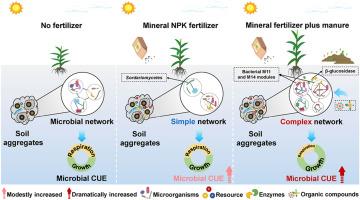Long-term manure application enhances carbon use efficiency in soil aggregates by regulating microbial communities in cropland
IF 10.3
1区 农林科学
Q1 SOIL SCIENCE
引用次数: 0
Abstract
Microbial carbon use efficiency (CUE), a key metric reflecting the allocation of carbon between microbial growth and respiration, plays a central role in predicting soil carbon (C) dynamics. Microbial CUE is influenced by soil aggregates that create nutrient heterogeneity, and long-term fertilization may alter these heterogeneous microsites. However, the effects of long-term fertilization on microbial CUE across different aggregates remain unclear, limiting mechanistic understanding of soil C cycling at the microscale. Here, a 34-year field experiment was conducted with five treatments including no fertilizer (CT), mineral nitrogen (N), mineral N, phosphorus and potassium (NPK), manure-only (M), and combined mineral fertilizer and manure (NPKM). Microbial CUE was measured in bulk soil and in >2 mm, 0.25–2 mm, and <0.25 mm aggregates using an 18O-H2O labeling approach. Metagenomic sequencing, enzyme activity assays, and substrate analyses were integrated to examine how fertilization altered interactions among aggregates, substrate quality, and microbial communities affecting CUE. Results showed that, compared to CT, manure application (M and NPKM) significantly increased microbial CUE both in bulk soil and aggregates. While microbial activity and CUE differed among aggregates under CT and NPK, manure application homogenized CUE across aggregates. Further analysis revealed that manure application regulated enzyme activities and substrate quality, which affected key bacterial modules (M11 and M14) and consequently modulated microbial CUE. These findings underscore the role of manure in enhancing microbial CUE and suggest that accounting for manure-induced microscale homogenization can improve predictions of SOC dynamics in global C models.

长期施用有机肥通过调节农田微生物群落,提高土壤团聚体碳利用效率
微生物碳利用效率(CUE)是反映微生物生长和呼吸之间碳分配的关键指标,在预测土壤碳(C)动态中起着核心作用。微生物CUE受到土壤团聚体的影响,这些团聚体产生养分异质性,长期施肥可能会改变这些异质性的微生物位点。然而,长期施肥对不同团聚体微生物CUE的影响尚不清楚,限制了对微观尺度土壤C循环机制的理解。本试验采用无肥(CT)、无机氮(N)、无机氮磷钾(NPK)、单肥(M)和无机肥粪配施(NPKM) 5种处理,为期34年。采用18O-H2O标记法测量大块土壤和2 mm、0.25 - 2 mm和0.25 mm团聚体中的微生物CUE。宏基因组测序、酶活性测定和底物分析被整合在一起,以研究施肥如何改变团聚体、底物质量和影响CUE的微生物群落之间的相互作用。结果表明,施用有机肥(M)和氮肥(NPKM)显著提高了土壤和团聚体中微生物CUE含量。土壤施肥和氮磷钾处理下不同团聚体的微生物活性和CUE存在差异,但施用有机肥使团聚体间的CUE均质化。进一步分析表明,施用有机肥可调节酶活性和底物质量,从而影响关键细菌模块(M11和M14),从而调节微生物CUE。这些发现强调了粪便在增强微生物CUE中的作用,并表明考虑粪便诱导的微尺度均匀化可以改善全球碳模型中有机碳动态的预测。
本文章由计算机程序翻译,如有差异,请以英文原文为准。
求助全文
约1分钟内获得全文
求助全文
来源期刊

Soil Biology & Biochemistry
农林科学-土壤科学
CiteScore
16.90
自引率
9.30%
发文量
312
审稿时长
49 days
期刊介绍:
Soil Biology & Biochemistry publishes original research articles of international significance focusing on biological processes in soil and their applications to soil and environmental quality. Major topics include the ecology and biochemical processes of soil organisms, their effects on the environment, and interactions with plants. The journal also welcomes state-of-the-art reviews and discussions on contemporary research in soil biology and biochemistry.
 求助内容:
求助内容: 应助结果提醒方式:
应助结果提醒方式:


